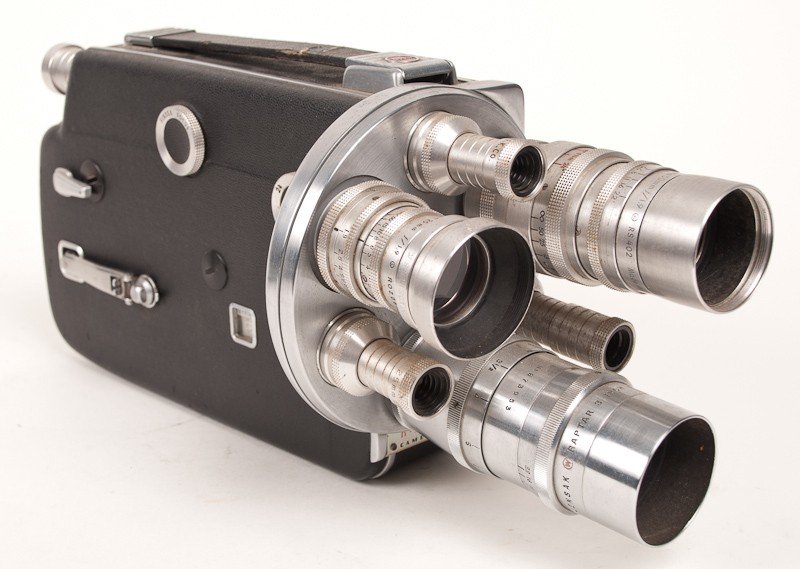Doug Kerr
Well-known member
I have very little experience with cinematography, either film or digital.
Somehow I have lately been doing a great deal of research into (and, I'm afraid to say, acquisition of) Kodak ciné cameras from the period 1923-1956.
Although I have regularly railed out against this validity of this notion, when dealing with the 36 mm × 24 mm still camera frame format, we tend to thing of a 50 mm lens as "normal". This is often related to the diagonal frame size, which it about 43.3 mm.
If we now move into the world of 16 mm cinematography, where the standard frame size is about 10.3 mm × 7.5 mm (a diagonal of 12.7 mm), we find that, for the Kodak cameras at least, it is almost universal to furnish them with a lens of 25 mm focal length. This yields a substantially smaller field of view than the fabled 50 mm lens on a full frame 35 mm frame camera.
On the 8 mm ciné camera front, where the frame dimensions are nearly half those in 16 mm work, it was very common to furnish the cameras with a 13 mm lens, the field of view being almost identical to that for the 16 mm cameras.
Do we have any idea what might have led to this custom?
The camera that basically brought an (elegant) end to the Kodak line of 16 mm movie cameras, the Ciné-Kodak K-100, was introduced in 1945 for the single lens version, and 1956 for the three lens turret version (formally called the Ciné-Kodak K-100 Turret). The latter version is often found in the field with lenses of 15 mm, 25 mm, and 102 mm in the turret.
To put this in context, here we see a lovely K-100 (albeit equipped with a rather different stable of lenses):

Kodak Ciné-Kodak K-100 (turret version)
The three things that look like garden hose repair fittings are viewfinder objective lenses, each matched to one of the objective lenses so as to give the viewfinder a field of view matching that given the camera by that objective lens.
Yes, of course, I bought one of these (just today), it having a 15 mm f/2.7 and a 25 mm f/1.9 in the turret, which has room for a further lens and its matching viewfinder lens. (One with a full complement of lenses would be beyond my budget for this project!)
You may note that the lens axes are "splayed" outward, a consequence of the turret being a shallow cone with its apex outward. This arrangement is to militate against the possibility that cohabiting lenses would interfere with one another either physically or by getting in each other's fields of view (the latter of which could well happen if one lens were a wide angle lens and another a physically long telephoto lens).
Just what I need!
Best regards,
Doug
Somehow I have lately been doing a great deal of research into (and, I'm afraid to say, acquisition of) Kodak ciné cameras from the period 1923-1956.
Although I have regularly railed out against this validity of this notion, when dealing with the 36 mm × 24 mm still camera frame format, we tend to thing of a 50 mm lens as "normal". This is often related to the diagonal frame size, which it about 43.3 mm.
If we now move into the world of 16 mm cinematography, where the standard frame size is about 10.3 mm × 7.5 mm (a diagonal of 12.7 mm), we find that, for the Kodak cameras at least, it is almost universal to furnish them with a lens of 25 mm focal length. This yields a substantially smaller field of view than the fabled 50 mm lens on a full frame 35 mm frame camera.
On the 8 mm ciné camera front, where the frame dimensions are nearly half those in 16 mm work, it was very common to furnish the cameras with a 13 mm lens, the field of view being almost identical to that for the 16 mm cameras.
Do we have any idea what might have led to this custom?
The camera that basically brought an (elegant) end to the Kodak line of 16 mm movie cameras, the Ciné-Kodak K-100, was introduced in 1945 for the single lens version, and 1956 for the three lens turret version (formally called the Ciné-Kodak K-100 Turret). The latter version is often found in the field with lenses of 15 mm, 25 mm, and 102 mm in the turret.
To put this in context, here we see a lovely K-100 (albeit equipped with a rather different stable of lenses):

Kodak Ciné-Kodak K-100 (turret version)
The three things that look like garden hose repair fittings are viewfinder objective lenses, each matched to one of the objective lenses so as to give the viewfinder a field of view matching that given the camera by that objective lens.
Yes, of course, I bought one of these (just today), it having a 15 mm f/2.7 and a 25 mm f/1.9 in the turret, which has room for a further lens and its matching viewfinder lens. (One with a full complement of lenses would be beyond my budget for this project!)
You may note that the lens axes are "splayed" outward, a consequence of the turret being a shallow cone with its apex outward. This arrangement is to militate against the possibility that cohabiting lenses would interfere with one another either physically or by getting in each other's fields of view (the latter of which could well happen if one lens were a wide angle lens and another a physically long telephoto lens).
Just what I need!
Best regards,
Doug

